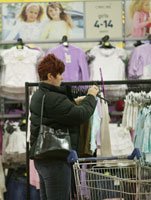RFID Moves Closer to Retail Sales Floors
Radio frequency identification (RFID) may be coming to the selling floor sooner than expected.
While some researchers have indicated that placing RFID tags on items is a good decade away, suppliers and other experts think otherwise.
Their case recently received some fuel when it was announced that Britain’s top supermarket chain and RFID pioneer, Tesco PLC, is coming to the United States with a rollout of its “Express” stores next year.
The retail giant is targeting the West Coast first and plans to invest $435 million a year for its U.S. expansion. Tesco officials have not indicated whether they will outfit their U.S. stores with RFID, but in the United Kingdom, it has been among RFID’s early adopters.
The technology employs wireless scanners that read barcoded tags embedded with microchips from afar. The chips can store thousands of bits of information. “FastPass” systems on toll roads employ RFID technology. Some library systems use it. Wal-Mart Stores and Target Corp. have been implementing it at the warehouse level.
Bringing the technology onto the sales floor has been met with some resistance because of high costs and privacy concerns. Numerous privacy-advocacy groups have argued that RFID is an invasion of privacy as the technology can track purchases beyond the sales floor and into private homes. The issue put an end to store-level projects launched by Italian retailer Benetton and a pilot project by Wal-Mart a few years ago.
Getting cheaper
As for its cost structure, suppliers have balked at the price of tags, scanners and other hardware required.
New technology from suppliers such as Lake Forest, Calif.–based Vue Technology has been able to bring some of those costs down by creating a multiplex of antennae that can be read by one reader instead of a scattered system, which requires numerous readers. The cost of each reader can run up to $2,000 each. Vue’s system can reduce the traditional approach to 1/20th of the price, Vue Chief Executive Robert Locke said.
Vue, a 5-year-old firm that specializes in item-level RFID, has invested more than $20 million in RFID systems. The company is considered the market leader and has worked with Tesco, Best Buy and others.
Locke thinks item-level RFID will begin rolling out as soon as this year.
“Our focus is to bring real value to RFID. We think itemlevel RFID has already arrived and it will be a killer application for the apparel and footwear markets.”
Even market analysts agree that item-level RFID will be where the real returns on investment will come. Manufacturers have viewed it as being a cost of doing business with Wal- Mart.
Locke said Tesco has been using RFID at the store level with CDs and DVDs and has been able to reduce out-of-stock merchandise by 50 percent with RFID.
Citing another case study for a shoe store in Japan, Locke said productivity doubled using RFID. Stock clerks were able to find certain SKUs in half the time with it. Sales increased 10 percent using RFID.
“Having merchandise in stock is critical,” Locke said. “If you’re an apparel manufacturer and a store advertises a sale on underwear and they run out, chances are the consumer will buy another brand.”
Wal-Mart expanded its RFID program to help it replenish goods by linking it to the point of sale and generating pick tickets when inventories reach a certain level.
Locke said high-end apparel and footwear retailers stand to benefit the most. “Tags from companies like Avery Dennison are down to 12 cents each. A retailer that is selling jeans at $100 each can absorb that easily,” he said.
A December 2005 report by Boston-based AMR Research supported that claim. The report said RFID-enabled item-level inventory-tracking pilot projects yielded stock availability improvements of more than 50 percent in targeted merchandise categories.























